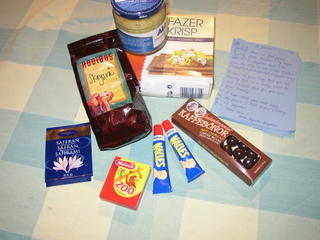Last year I began reading everything on food labels, and was horrified by what I found. It was clear that the interests of the food manufacturers are not necessarily those of the individual. So I've been cutting down as much as possible on all processed foods, even apparently innocuous products such as tinned tomatoes, orange juice or bread. I haven't cut them all out all the time, and I certainly wouldn't want to - it's extremely useful to be able to open a tin of chickpeas in order to make hummous quickly. The new regime isn't about being neurotic about food, it's about making life as healthy as possible at home, in order not to worry too much when we're out and about. It's also about taking a view, aiming for balance, not fretting too much. In this way, lapses don't mean the end of the regime (as they would if we were "on a diet"), they just mean you know you should try a little harder for a day or two. This also means I can experiment with food - and I do, all the time.
So I began thinking about the bread we eat. I used to make it, but the children came to prefer sliced white flannel (what a galling admission!), and it gradually petered out. I got out of the habit. This was partly because it was a time-consuming and fiddly sort of breadmaking, involving searches in the supermarket for yeast, weighing ingredients out exactly, and generally fretting. I've been reading Dan Lepard's wonderful book, The Handmade Loaf, which proposes a very different, traditional method, using a starter. This is the bread which has been made for centuries, first in Europe, then taken by those admirable women who travelled across America in wagons, so that once on the West coast it became the sourdough loaf which is such a feature of San Franciscan cooking. This is food which you can adapt endlessly; it's food which involves sharing and generosity; it's food which fits in with a busy life. It also frees you from the food processing industry, especially if you can find a local source of flour.
Once you have a starter - yeast and flour, water, perhaps some sugar - all you have to do to make bread is mix part of it with some flour. Then you feed your starter with more flour, so that the process can begin again. If you want to help someone out by giving them some of your starter, just add a little more flour and water. If you don't want to make bread for a while, just leave the starter in the fridge until you do. When the moment comes to make bread, you can measure it all out carefully - or you can use your ladle to approximate the quantities. Despite using the same starter, you can make all kinds of different breads by changing the shape, the flour, the flavourings, the method of proving and kneading. It turns out that most bread has traditionally been made using a starter (to keep the yeast alive in the absence of a shop); it's only in the days of so-called convenience food that we have complicated things by making ourselves dependent on the supermarket.
It's not remotely complicated to make a starter, it just takes a few days. That is to say, it takes you a couple of moments, but you can't use it for a few days.
Starter
Dissolve 3 tsp dried yeast in 450ml warm water. Add 375g strong white flour. Cover, put to once side for at least three days, stirring twice a day. I used one of those French jars, about 8 or 9 inches tall, which was fine, except at the very beginning when it bubbled over, so I switched to a big bowl, which I covered with a teacloth. It seemed to be a one-off, because I now keep the starter in a French jar, and although it bubbles up when I add flour and water, it doesn't get anywhere near to overflowing.
Bread
1. Sift 175g strong white flour with 75g wholemeal flour, and some salt if you want (I leave it out, for me it's part of the point of making bread; apart from taste, the main effect of salt is to improve the keeping qualities of the bread).
2. Add 500ml of starter. Mix the starter and flour, adding a little more water to make a firm dough. You will have to feel your way here, so it would help if you've made dough before. Generally, you want to avoid using too much water, otherwise your loaf becomes rather hard (my early attempt at making buns, years ago, being known as bullets on account of too much water).
3. Knead the dough; you want it to be smooth, you want it to be what bakers call elastic, you'll know it when you get there, even if you haven't made bread before. It'll take 10 minutes by hand, no time at all in a Kenwood (indeed, using a machine, the danger is that you over-knead it). I can't give any advice about a breadmaker, because I've never used one.
4. Now it needs to be left to double in size. This is the moment when you can take control of the timings. If you want the loaf soonish, then leave it somewhere warm, and it will take about 2hrs. If you want it for breakfast, then put the loaf in the fridge, and it will take all night.
5. Knock it back (this just means giving it a punch to let out all the air), shape it, put it on a floured baking sheet, and leave it to prove. It's ready to bake when it's doubled in size. Slash it, cook it in a hot oven, 220C - check if it's done after half an hour (tap it on the bottom, it's ready when you get a hollow sound). It might take up to an hour.
Replenish the remaining starter with flour and water in the same quantities (a little maths is in order here). Now it will bubble away, waiting for the next loaf. This time, you could use different flour; you could decorate it with poppy seeds; you could dig out a recipe for ciabatta and make that instead (if it says to use processed/dried yeast, just use your starter). The second time you make a loaf using this method, you can just get on with it, because the starter is there, waiting for you to use it. Keep the starter in the fridge, just get it up to room temperature before you start mixing.
When you are adapting recipes, don't fret too much. The yeast in the starter will do most of the work for you, and it's forgiving stuff. Remember that the women who crossed America in the wagons didn't have scales, they just had measures, so the best way to claim this recipe for your own, to make this something you can do quickly and easily, is to work out how many ladles of starter are needed for each ladleful of flour in the bread, and how many ladles of water and flour you need to replace what you have taken out of the starter. I found it a little complicated to work out (maths is not my strong point), but once you've done it, you never need to use your scales when you are baking bread. Dan Lepard's book gives percentages of ingredients for each recipe, and the point of that is so that you can use a ladle rather than a scale.
Jamie Oliver's books have good bread recipes, and sensible advice on how to go about making your own. The key thing is that once you've got this going, it only takes a few moments to mix. If you mix it after breakfast, you've got a loaf for lunch. Or you can slow it down so that it's ready at supper time. Either way, it's delicious, and it makes you feel very clever and competent.
I made the starter last week; I made the first loaf with it on Saturday, with the help of Catrin (she was extremely helpful with the maths). She's just emailed to say that she's made a starter. I'm looking forward to reading her blog about how the bread went ... and I'll keep you posted about where I go from here.
Joanna
PS I forgot to say, the bread was delicious - I brushed it with water and dotted it with fennel seeds. We ate it for lunch, and it was gone in a moment.












